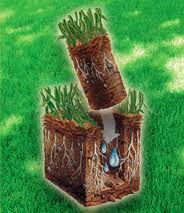With the arrival of fall, all lawns can benefit from a “pick-me-up” to recover from the stresses of another summer season. On their own or in combinations, heat, drought, insects, disease and increased foot traffic can lead to thinning turf and bare patches where lust, green grass used to be.
A Winning Combination
Aeration with overseeding is a tried-and-true method of repairing lawns suffering from summer stress. Fall is a great time for this service, since growing conditions are more favorable and there’s less competition from weeds. Plus, any new grass planted in the fall will have plenty of time to get established before the taxing summer season returns.
The Process
The first step is to make several passes over the lawn with a machine known as a core aerator. This machine removes plugs (or cores) of soil and thatch from the lawn, creating holes through which air, water and fertilizer can more easily travel to the roots. With aeration, a stronger, deeper root system is encouraged; compacted soil is loosened up; and excessive thatch is broken down as the plugs dissolve through rainfall and watering.
Next, the lawn is overseeded by broadcasting new grass seed throughout the turf with a spreader. The holes left behind by aeration will “catch” the seed and provide better seed-to-soil contact for improved germination rates. To ensure successful growth, the soil needs to be kept moist for several weeks after overseeding. If there’s no rainfall, regular watering will be necessary.
Lawns that are aerated and overseeded in the fall will be stronger going into the winter months ahead. Plus, they’ll be thicker, greener and much better prepared for any challenges next year’s growing season throws their way!



